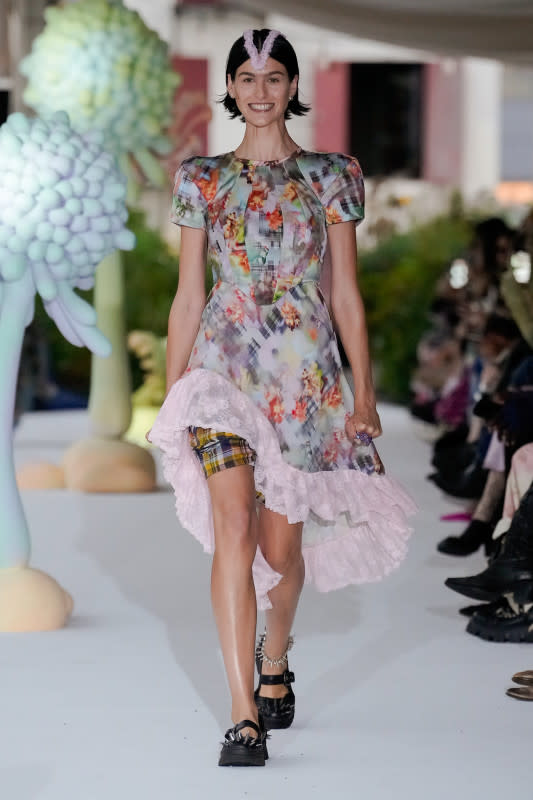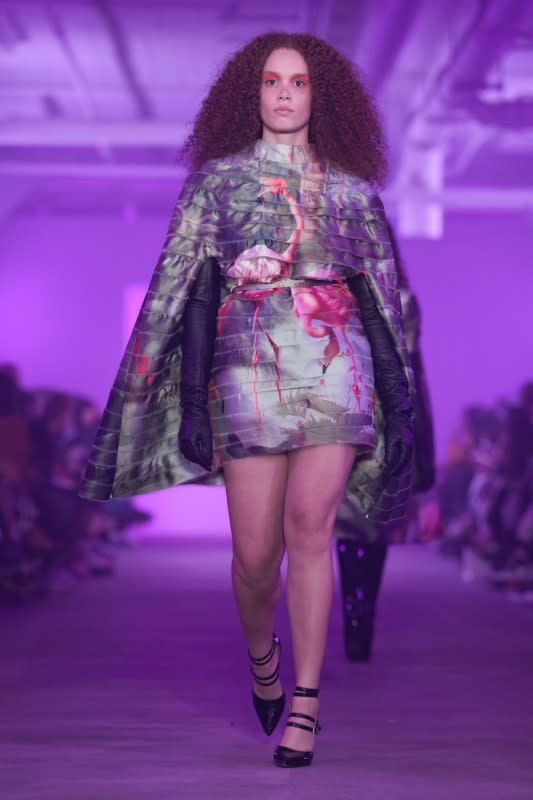AI-Generated Prints on the Runway Pose Existential Questions About Design's Future
Prints are one way for designers to define a seasonal collection and differentiate themselves in a crowded market, but what does it mean when those designs are created by a computer, rather than a human? During New York Fashion Week's Fall 2024 season, prints generated by artificial intelligence made quiet marks on catwalks like Bach Mai and Monse, leaving us with questions about where today's rapidly advancing technologies belong in fashion design.
Fashion is no stranger to generative AI's explosive development and influence as of late. Companies are already using it to calculate carbon impact, implement virtual try-on technology and optimize supply chains, for example. But this season, its more visible use in creating prints brings us to another point of reflection: Why use artificial intelligence (instead of graphic designers) to make prints? Are their legal or ethical concerns? Do customers care?
Collina Strada's Hillary Taymour became something of a pioneer when she openly used AI for Spring 2024 to create runway sculptures, clothing patterns and prints. One season later, Bach Mai and Monse also used it to develop prints in their Fall 2024 collections. One of the most popular text-to-image generators (and the one Mai used) is called Midjourney, released in July 2022. After generating a satisfactory image via a text prompt input, a user can download a high-resolution version, tweak it in image editing software and send it to a fabric manufacturer (as one might for any custom print). With the resulting rolls of fabric, designers can cut and sew their collections like normal.
Fall 2024 marked the Monse design duo's first attempt at using AI to come up with prints: "Our design director found a way to make an eerie floral print feel very much of the brand. What we do is always take something that is familiar to you, like a flower, and fuck it up," Co-Creative Director Fernando Garcia told Fashionista backstage at the runway show in New York.

Photo: Launchmetrics Spotlight
Holger Harreis — senior partner at McKinsey & Co., and one of the firm's co-authors on a report uncovering generative AI's potential to change fashion ahead (including boosting the industry by up to $275 billion) — is particularly cognizant of generative AI's benefits. AI-generated prints, he says, offer the ability to create more in less time. (This can be particularly helpful for smaller designers who may be more rushed with fewer resources to finish collections in time for fashion week and production runs.) But Harreis also flags logistical and ethical drawbacks.
"The very obvious one is potential IP infringements. [AI is] not creative in the sense of real human creativity that creates something completely new, but it only generates something on the basis of what it has learned. There is a likelihood that, inadvertently, you'll get something that actually has IP rights from someone else," Harreis tells Fashionista, adding that designers should be cautious of AI biases and "hallucinations" (or, generated material that's false).
He continues explaining that AI-generated printmaking might make it easier for a brand to save money by not needing to hire a graphic designer or not needing one for the same scope of work as it would without AI. But Mai, who used Midjourney to generate his flamingo and "bondage floral" prints, says it was more about using an additional tool than replacing someone.
"It's not like you can just go in, and all of a sudden you're a genius print designer. It's like a paintbrush that the print designers have. They can use it to enhance their work and their output. They're inputting their know-how, their technique," he says. This idea of AI as a tool has led to new concepts like AI artists, for example. Mai adds, "It's up to you how you use it and incorporate it. It can be used to just explore. It can be used to bounce ideas around and get quick visualizations of things that can then be further refined with an artist."
Despite fears of how AI might absorb and extinct certain jobs (and create new ones), Mai has an optimistic attitude. "Certainly we don't send as many letters because we have email, but it doesn't mean we stopped communicating with each other," he points out.
Harreis believes the adoption of AI will happen as "a gradual ramp-up," and Mai is already witnessing this: "[Printmaker Abby Lichtman and I] were recently at [industry trade show] Première Vision New York, which has a big selection of print designers. It was interesting to see other print designers there also starting to use AI to develop their prints. Sometimes, there's a certain hand to it, and sometimes you can't tell. But it is something that's definitely happening, and it's happening not just in this sector but in all sectors, which is the incorporation of AI as a tool."

Photo: Launchmetrics Spotlight
Like with any major change, generative AI used for design is going to require customers to get on board. Harreis says that transparency will be key for designers, especially when it's incorporated in design, because customers want to know.
"If we look into our consumer sentiment surveys across the globe, what consumers will expect is that there is a clear tagging saying this is generative AI-based. Or, they'll expect a brand to say, 'Look, we're just not going to do it. You can trust us,'" the McKinsey expert says. (It's similar to how grocery shoppers may expect foods to be labeled with GMO labels if they're genetically modified.)
The use of generative AI isn't an issue fashion and other creative industries face alone. Rather, its adoption and development continue to pose questions across sectors. "Many of the founding [figures] of generative AI have called for a pause in a manifesto to be able to steer very consciously in a future direction. That does tell us how big the step really is," Harreis notes.
"It will not mean the end to humankind, not the end to humanity and not the end to human creativity. I do believe, however, that we are very prone to losing some capabilities that we've built over centuries... [capabilities] you could even argue that human evolution has led us to having," Harreis cautions. "By not using them, we'll see an adverse evolution that will make us lose these capabilities. This is where we probably need to have more of those ethical discussions that will question, what are we willing to accept versus not?"
There is a push for businesses and industries to create AI councils to steer benchmarks for what's permissible and what isn't, but fashion is largely bereft of such guidance for now. Though fashion schools are incorporating AI technology in curriculum for the next generation of designers, already-working designers face uncharted territory without such auspices. In a recent Vogue Business piece, designers weighed in on the topic, many questioning if and how AI belongs in fashion design.
"I'm very romantic and old school about how I approach things, but if history has taught us anything, it's to not be afraid of newness," Carolina Herrera Creative Director Wes Gordon told the publication. Private Policy's Siying Qu said it may be best for research: "Instead of using it to design — because we still very much believe design is a very human way of expressing our emotions — we want to use AI for its knowledge. It's very rare to talk to an entity that's so knowledgeable."
The recently-revealed Fall 2024 collections will serve as something of a test run for AI-generated prints, a very specific use of it in only one category within design. Labels like Collina Strada, Bach Mai and Monse will need to continue assessing how AI will or will not play a role ahead: not just in backend and business processes, but in creative outputs as well.
Never miss the latest fashion industry news. Sign up for the Fashionista daily newsletter.
